|
Caudwell Xtreme Everest Expedition
March–June 2007
Please
click here for more photos of the
2007 Caudwell Xtreme Everest Expedition
After climbing through the night, the red glow
of dawn gradually began to fill the eastern
sky over Makalu (8,462m). With each breathless
step, we had climbed inexorably upwards until
eventually we crested the South Summit. There
was only a short distance along a twisting
knife edge snow ridge to the infamous Hillary
Step and a short distance beyond that lay the
summit of Everest. An Xtreme dream was about
to be realised.
At 6.30 am on 23rd May 2007, five members of
the Caudwell Xtreme Everest climbing team,
accompanied by their sherpas, reached the
summit of Everest (29,035ft or 8,850m) from
the Nepalese side.
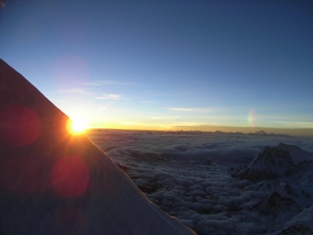
http://www.youtube.com/watch?v=i7tDlZBs07c
The Caudwell Xtreme Everest Expedition was
four years in the planning and is the largest
medical research expedition ever undertaken.
There were 240 participants, 22 tonnes of
equipment and the total cost of the expedition
was approximately £2,000,000. The complex
science program aimed to investigate the
adaptation of the human body as it
acclimatises to extreme altitude, using the
shortage of oxygen as a model for patients in
intensive care units.
Baseline studies in London
Two months before the expedition left for
Nepal, the team underwent a week of baseline
testing to assess responses to various
physical and mental challenges. This was also
the final opportunity to test equipment before
shipping it to Nepal.
After a somewhat fraught journey from the UK,
we arrived in Kathamndu and rapidly settled
into the peaceful haven of the Summit hotel.
Once again ground arrangements were by Simon
Lowe and his excellent team at Jagged Globe
and Kit Spencer and his superb team at the
Summit Hotel.

Walk in
There were incredible views of the Himalayan
chain as we flew from Kathmandu in a tiny
propeller driven plane. Lukla airstrip is
angled upwards at 15-20 degrees, meaning not
only that it is unfeasibly short, but also
that the pilot has only one attempt to get the
approach correct. At the airport we were
greeted by a chaotic crowd of porters, sherpas,
yak drivers and lodge owners awaiting the
planes arrival, each vying for potential
business. Trekking out of the village, the
pace of life slows. You walk for a couple of
hours on steep narrow mountain paths, crossing
swaying suspension bridges high above the
roaring Dudh Kosi, and then take tea at a
lodge, before moving on again.
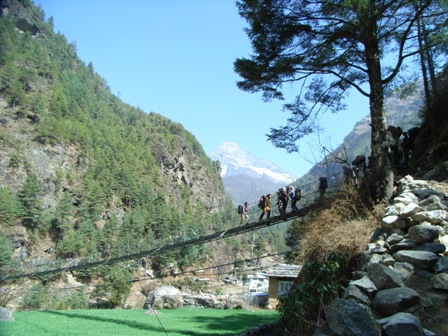
%20from%20Namche%20Bazaar.jpg)
On the long haul up to Namche Bazaar we turned
a corner and caught our first glimpse of Mount
Everest with a three mile plume of snow
generated by the jet stream. At 29,035 feet
(8,850m) tall every child learns that this is
the highest mountain in the world. It has been
formed by the up thrusting of land as two
continental plates collide, and is continuing
to grow in height. It is named in honour of
the first Surveyor General of India and was
first climbed in the pre-monsoon season by
Edmund Hilary and Norgay Tenzing on May 29th
1953.
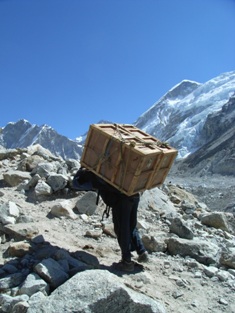
Basecamp
After ten days trekking we arrived in Basecamp
(5,300m). This bleak and desolate place is on
the Khumbu Glacier and was to be our home for
the next three months. Our sherpas had cleared
a large area for our camp. There were 2 cook
tents, a mess tent, a medical tent, 3
experimental tents, a maintenance tent, a
communication tent, toilet tents, shower tents
and everyone had there own personal tent.
http://www.bbc.co.uk/sn/tvradio/programmes/horizon/broadband/tx/everest/basecamptour/
The shrinking world of modern technology made
keeping in touch with our families more
straightforward than in years gone by.
Although letters could be sent by runner back
to Namche Bazaar and then on by post,
satellite phone or internet communications
were much faster and more reliable. The
biggest problem was the huge cost- the
expedition phone bill came to $45,000.
Initially the food seemed good, but over time
and with limited access to fresh food it
became increasingly dull. Appetite suppression
and weight loss are recognized phenomena and I
managed to drop from 80kg to 66kg during the
expedition.
http://www.bbc.co.uk/sn/tvradio/programmes/horizon/broadband/tx/everest/
journey/journey_stages/base_camp/index.shtm
The Icefall dominates Basecamp like no other
glacier I know. Basecamp is actually placed on
the glacier just as it takes a right angled
bend and is on the move in two ways all the
time. Firstly it is melting fast and everyday
new rivulets develop as the glacier melts in
the hot sun. Rocks and tents are left high and
dry as the surrounding ice melts giving the
impression of the tide going out. Secondly the
entire camp is slowly on the move down the
valley, and every so often there are pistol
shot noises as the ice readjusts its position.
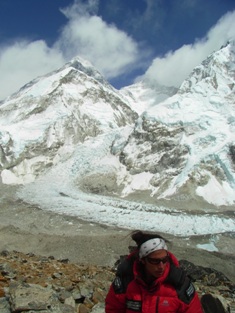
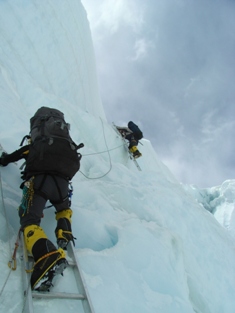
Khumbu Icefall and Western Cwm
The route climbs rapidly through some of the
most sensational ice landscape in the world.
It tackles the vertical seracs and the gaping
crevasses head on, using a combination of
fixed ropes and aluminium ladder bridges
(often using up to 4 tied together). In some
ways the route is a sociable place as one
meets friends and climbers from other
expeditions, but speed is the essence for
safety, since it reduces the time spent in
this exquisitely beautiful but hostile and
potentially dangerous environment. Our
strategy was to acclimatise elsewhere on safer
ground, so that we could move through the
icefall more quickly.
http://www.bbc.co.uk/sn/tvradio/programmes/horizon/broadband/tx/everest/journey/journey
_stages/western_cwm/index.shtml
Lhotse Face
‘Coffee, tea or French onion soup?’ was the
question Sundeep asked me, as we settled into
Camp 3, perched halfway up the Lhotse Face at
about 7,100m. The Face is a 1,500m (4,500ft)
ice and snow slope angled at between 40-50
degrees. Our campsite (!) was a narrow strip
of horizontal space and had been carved out of
the steep ice and snow slope by our sherpas.
On the one side blocks have been cut out of
the slope, and on the other the blocks have
been used to build up a ramp to give an eight
foot wide horizontal terrace to place our
tent.
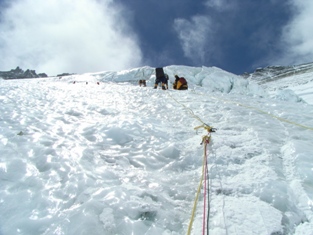
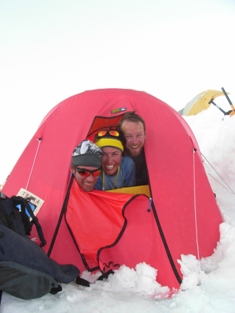
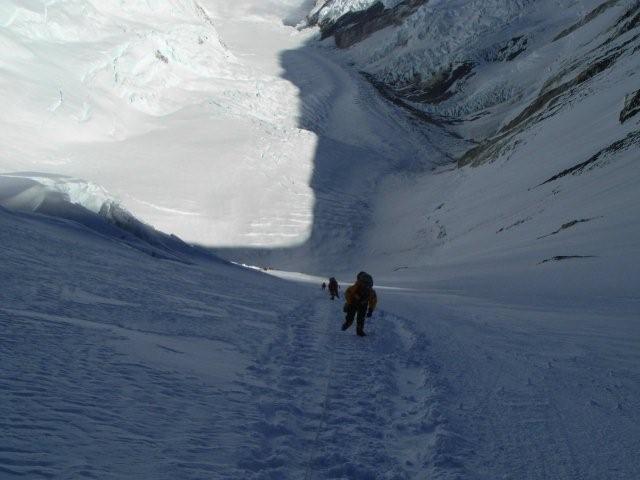
The intention had been to spend the night at
over 7,000m as part of the acclimatisation
process. It was a couple of hours before
sunset, and we were just settling down to a
brew and the slow process of melting snow in
order to rehydrate ourselves when a crackle
came over the VHF radio. The weather forecast
predicted a storm which threatened 20-30cms of
snow. The Lhotse Face is no place to be in a
snowstorm in particular because of the risk of
avalanche. The options were to sit the
possible storm out, and hope that the forecast
was wrong and complete our acclimatisation
sojourn, or to pack up rapidly and descend the
fixed ropes and try to get back to the safety
of Camp 2 before dark. A rapid conversation
took place, and with safety paramount, we
packed up and abseiled down the fixed ropes,
getting into Camp 2 just as it was getting
dark.
http://www.bbc.co.uk/sn/tvradio/programmes/horizon/broadband/tx/everest/journey/journey_stages
/lhotse_face/index.shtml
South Col
After a week at lower altitudes eating to
regain lost weight, it was time to head back
up the mountain through the precarious Khumbu
Icefall, the immense and very hot Western Cwm,
up the steep and treacherous Lhotse Face,
through the Yellow Band, across the Geneva
Spur and finally up to the South Col (7,980m).

On first arrival, the South Col had a
deceptively benign appearance. In the sun and
without any wind, it was warm enough for T
shirts. It was only later when the sun set and
the wind picked up that we began to appreciate
the true harshness of the place. Temperatures
plummeted to as low as -35C, and with oxygen
levels 1/3 of those found at sea level, we
began to appreciate what was meant by the term
the ‘death zone’. At this altitude, the body
is deteriorating all the time, and life is
unsustainable for any length of time. Without
oxygen even the simplest of tasks such as
brushing ones teeth took on gargantuan
proportions, requiring a rest to complete the
task.
Most teams arrive at the South Col in the
early afternoon, they then spend a few hours
rehydrating and sleeping before setting off on
their summit attempt somewhere between 9.00pm
and midnight. Our plan was different; we had
the most ambitious range of scientific
experiments ever undertaken at this altitude
to undertake in the world’s highest
‘laboratory’ at the South Col (8000m). We
spent a day setting up equipment, followed by
two days of experiments ranging from cerebral
perfusion studies to maximal bicycle exercise
tests. At rest and off supplemental oxygen our
blood oxygen saturations were between 48-56%,
(normally 99%) and with exercise these levels
dropped further, understandably our bodies
were deteriorating continuously. In total, we
spent 5 nights on the South Col- we believe
this is the longest anyone has ever spent
there.
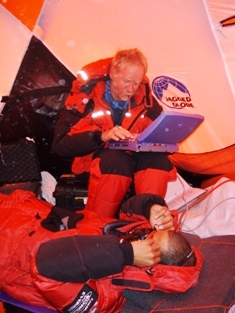
http://www.bbc.co.uk/sn/tvradio/programmes/horizon/broadband/tx/everest/journey/journey_stages
/south_col/index.shtml
Whilst on the South Col, we became involved in
one of the highest rescues ever undertaken. A
22 year old woman with cerebral oedema or
brain swelling was left to die by her team at
8,500m. Usha was found alone and unconscious
at 8,500m by an American guide Dave Hahn. He
spent 30 minutes giving her his oxygen, and as
she began to rouse, he radioed down to the
South Col asking for assistance. We sent
climbers, sherpas and oxygen up to help lower
her down the Triangular Face to our South Col
Camp. Three hours were spent stabilizing her
in a tent before a team of climbers and
sherpas began the long carry and lower down
through the Yellow Band and Lhotse Face to
Camp3, arriving after the dark. A second team
spent the night resuscitating her before she
was lowered the rest of the way down the
Lhotse Face to Camp 2. She was finally carried
through the Icefall to Basecamp (the altitude
ceiling for helicopters rescues) and flown to
Kathmandu. She has subsequently lost a couple
of toes and the tip of her thumb from
frostbite but has otherwise has made a
complete recovery.
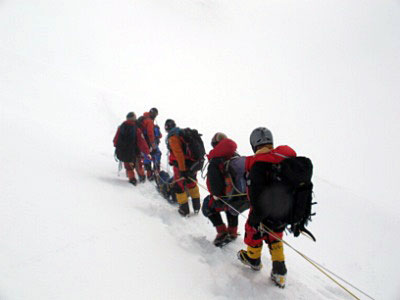
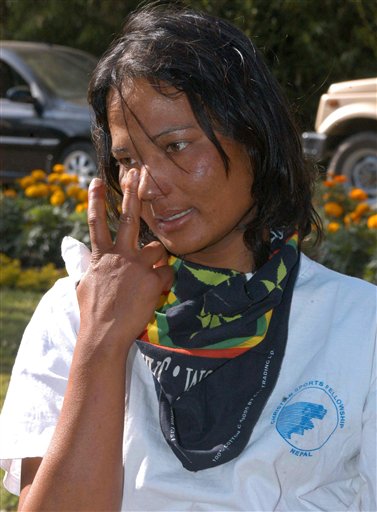
Summit
Ten sherpas and five climbers had set off from
the South Col (7,980m) at 9.30 pm on 22nd May.
In a bitterly cold wind we had crossed the
South Col Glacier, and steep climbing had led
to the 40 degree Triangular Face. The
spindrift driven by the strong winds had
filled in the previous steps, so breaking
trail was hard work. We arrived at the Balcony
in good time and took a short break, but a
combination of the cold, the dark and the wind
meant it was better to be moving.
The cold clear starlight night silhouetted the
South Ridge, which lead through a loose rocky
section up towards the South Summit. The
head-torches of our party twinkled above us as
we tackled the steep rock. After climbing
through the night, the red glow of dawn filled
the sky over Makalu. With each breathless step
we had climbed higher until we crested the
South Summit; beyond lay the Hillary Step and
the summit of Everest. An Xtreme dream was
about to be realised.
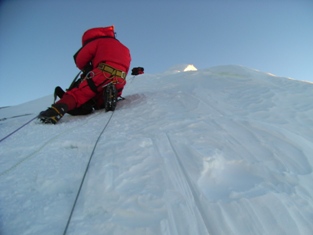


Between the South Summit and the Hillary Step
there is a switchback ridge made up of huge
surreal whipped meringue cornices which
overhang both the Kangshung Face to the East
and the South West Face to the West. There was
a strong cross wind, and with drops of over
8,000 feet on either side and clearly this was
no place to fall. I turned the flow rate on my
oxygen cylinder from 2 to 3.5 litres per
minute for the final hour of the climb. The
route twists and turns along a knife edge
ridge to reach the Hilary Step. This short
steep segment was adorned with a mass of rope,
mostly old and tatty but there was at least
one in reasonable condition. Having surmounted
the Step, a further 2-300m of relatively flat
ground led to the summit of Everest, the
highest point on earth.
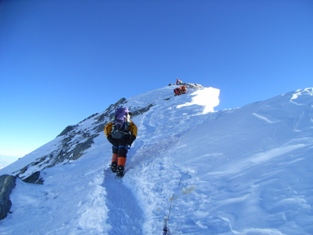

http://www.youtube.com/watch?v=i7tDlZBs07c
http://www.bbc.co.uk/sn/tvradio/programmes/horizon/broadband/tx/everest/journey/
journey_stages/summit/index.shtml
At last it was possible to climb no higher.
There was a mass of prayer flags fluttering in
the bitterly cold and strong wind. It was so
cold that we spent the shortest possible time
on the summit. Initially there was an enormous
feeling of elation shared with Mike, Sundeep,
Dan and Nigel, and huge thanks to Tashi, the
sherpa, who had shadowed me for the entire
climb. Then a few private moments were taken
to contemplate the effort and commitment
required to get to the highest point on earth.
There was also time to remember the support
and prayers of those nearest and dearest, and
then it was time to leave before the
penetrating cold and hypoxia endangered a safe
return, focusing on each and every step of the
return journey.
http://www.xtreme-everest.co.uk/news_detail.php?newsid=609
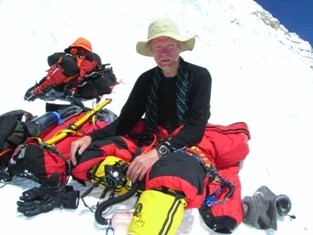
There are more photos of the 2007 Caudwell
Xtreme Everest Expedition in the
Caudwell Xtreme Everest 2007 Gallery
Why climb mountains?
The first question which you will ask and
which I must try to answer is this, "What is
the use of climbing Mount Everest?" and my
answer must at once be, "It is no use." There
is not the slightest prospect of any gain
whatsoever. Oh, we may learn a little about
the behaviour of the human body at high
altitudes, and possibly medical men may turn
our observation to some account for the
purposes of aviation. But otherwise nothing
will come of it. We shall not bring back a
single bit of gold or silver, not a gem, nor
any coal or iron. We shall not find a single
foot of earth that can be planted with crops
to raise food. It's no use. So, if you cannot
understand that there is something in man
which responds to the challenge of this
mountain and goes out to meet it, that the
struggle is the struggle of life itself upward
and forever upward, then you won't see why we
go. What we get from this adventure is just
sheer joy. And joy is, after all, the end of
life. We do not live to eat and make money. We
eat and make money to be able to enjoy life.
That is what life means and what life is for.
George Leigh Mallory 1922
Back
to top
|
|
